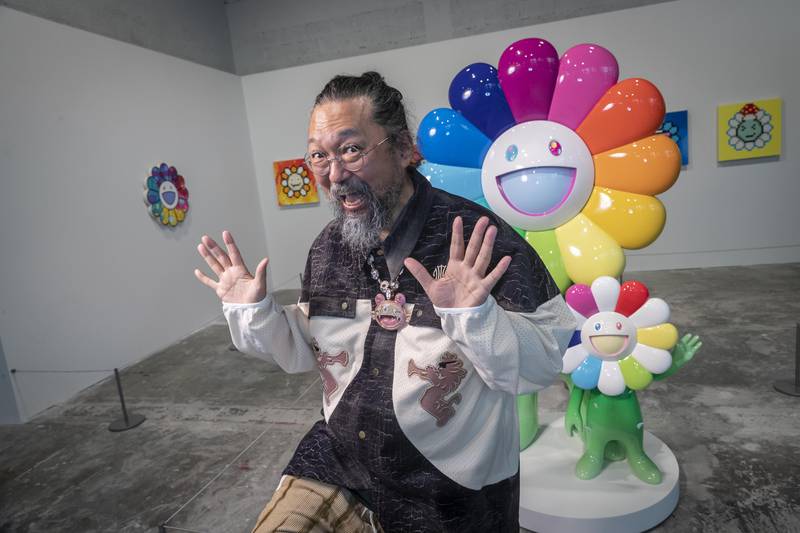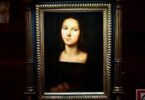Hareth Al Bustani
One of the most important artists of the contemporary era, Takashi Murakami is a living legend. Though he is often compared to Andy Warhol in terms of influence, such reductionist comparisons fail to grasp the full scope of his importance as a bridge between fine art and mass culture.
Growing up in post-war Japan, Murakami developed a distinctly Japanese style of Pop Art — blending traditional Japanese painting, wood-block prints and anime — as a way of transcending western forms of composition, and hierarchies of “high” and “low”.
Having conquered the international art world with astute commentaries on Japanese society, he then risked it all with a high-profile collaboration with Louis Vuitton — which was unheard of for an artist of his stature. It was a move that could have cost any other artist their career; but in Murakami’s hands, it paved the way for others to follow suit.
A sweeping collection of Murakami’s works is currently on show in DIFC as part of Perrotin’s inaugural exhibition at ICD Brookfield Place until January 28. We spoke to him ahead of the launch of Perrotin’s first Middle Eastern gallery, about the works on show.
:quality(70):focal(2642x1352:2652x1362)/cloudfront-eu-central-1.images.arcpublishing.com/thenational/JLHFGOLDORC45NP432AL32LOGQ.jpg)
Curated by the artist himself, the collection aims to give visitors a broad introduction to his work, starting with a series of colourful sculptures and acrylic paintings featuring his character, Mr DOB. “Nowadays you can see so many characters in the world of fine art, but back when I first presented a series of Mr DOB paintings, no one was doing it,” says Murakami.
Murakami created Mr DOB in 1993 as an exploration of the predatory psychological practices of mass marketing campaigns. An amalgamation of the Japanese characters Doraemon and Sonic the Hedgehog — who was taking the world by storm — the character held particular resonance in Japan, which had embraced many American cultural imports following the Second World War.
“The creation of a new character was a completely different practice from that in the American pop culture, of appropriating copyrighted mass images. Creating one’s own original icons meant minting a new artistic concept, one that declared that the Japanese were thinking differently from western art. I did it as an act that was meant to go beyond American Pop Art,” says Murakami.
“The most important thing was that it was a test to see whether minor culture from Japan and the Far East, when thrown into the western art world, could be viable as art. Before my generation, many Japanese contemporary artists used the exact western method, but I decided to create a new set of rules.”
:quality(70):focal(1327x663:1337x673)/cloudfront-eu-central-1.images.arcpublishing.com/thenational/UWDELAAFVJAVNDKJZZCTHZGEAY.jpg)
Originally trained in the Japanese Nihonga tradition of fine arts, Murakami’s fascination with pop culture led him increasingly blur the lines between visual dimensions and social hierarchies.
“When I was a university student, I was inspired by the Edo period artist Ito Jakuchu. My brain analysed the structure of his painting compositions, re-edited and redesigned it, and created a new form,” says Murakami.
“I called our post-Second World War Japanese culture ‘Superflat’. When I coined this term, I intended it to be a cross between the flattened-hierarchy structure of Japanese society, which had lost its confidence, and the flatness of Japanese people’s image recognition tendency.
“But by around 2000, with the spread of the World Wide Web, the averaging or flattening of information in the internet culture progressed, and I thought the whole world had become a Superflat society.”
:quality(70):focal(3227x1878:3237x1888)/cloudfront-eu-central-1.images.arcpublishing.com/thenational/GXGKUXXMYZCC3IIPTZITMQJUDQ.jpg)
The era coincided with a fascinating reversal of cultural exchange, with Japanese animation and gaming content suddenly being embraced across the world. “I think this indicates that people around the world are now able to resonate with the narrative based on the Japanese ‘loser’ mentality,” says Murakami.
“In Japan in the late 1970s, the-good-punishing-the-evil narrative structure was no longer viable, and good and evil were interpreted in different ways depending on one’s perspective. The logic of the loser, that is, came to be properly narrated.
“A good example is the robot anime genre, like Gundam and [Neon Genesis] Evangelion. Stories in which battling characters are in conflict with themselves as well as each other, narratives that converge on outcomes that are far from justice, are becoming the norm.”
The artist says this trend has survived the emergence of 3D animation in the US, which he traces back to the success of Toy Story (1995). Not only were the production costs of 3D graphics too high for the Japanese film industry, audiences simply were not interested in seeing Japanese 3D animation, he says. Theirs was a two-dimensional visual heritage.
:quality(70):focal(689x113:699x123)/cloudfront-eu-central-1.images.arcpublishing.com/thenational/2QRHNEICDBBKNNV6BPVBLT7WYY.jpeg)
“Perhaps, in a sense, because of this taste and tendency, the world of Japanese visual expression still indirectly preserves the geisha dance and kabuki, the styles involving two-dimensional spatial designs.
“The kimono is also not three-dimensional like western clothing, but is conceived from a single piece of cloth. Issey Miyake’s concept of creating his clothing from one piece of fabric has conceptualised this practice and his products embodied it.
“This 2D composition is nothing like Leonardo da Vinci or Michelangelo’s works; it is only the wandering of the eye across the 2D plane that gives the painting its vitality. There are very similar conditions in the painting industry as there are in the animated movie industry. So, Toy Story is like the Michelangelo and my work is something like the flat animation or the flat Japanese style of painting from the Edo period.”
Murakami says today’s generation of Japanese artists are more confident drawing from their own culture — and are able to sell well in their local markets. But, he adds: “Young Japanese artists still seem to be timid, and they aren’t eager to go out of the country.”
:quality(70)/cloudfront-eu-central-1.images.arcpublishing.com/thenational/ETUBOR26M36SD24IKE3YPPXV4Q.jpg)
However, he was never affected by such timidity. In 2001, he founded Kaikai Kiki Co, Ltd, a company that supports emerging artists by mounting exhibitions and selling merchandise, among other activities. The next year, he sparked up the controversial relationship with Louis Vuitton — re-imaging the brand’s signature monogram with injections of bright colour for the spring/summer 2003 Monogram Multicolore collection.
“When Louis Vuitton released my products, they sold explosively, yet the auction price of my art went down. People had mistakenly thought, ‘Ah, Takashi has started presenting his work to the mass market instead of the art market’.
Murakami was well aware of the risk. “It was my challenge to induce a shift in the values of art. Because Japanese people didn’t have the same western hierarchy or social pyramids, I believed that I was in a position where I could simultaneously work on mass products while creating very rare pieces of artwork. Then, after another five or six years, the price of my art on the market came back up to the same level as before. I think the art world understood that Takashi Murakami could survive.
:quality(70)/cloudfront-eu-central-1.images.arcpublishing.com/thenational/ECMZYVYZY5H5ZJKJ5MY5QJNS4I.jpg)
One of the biggest turning points was a 2007 Museum of Contemporary Art, Los Angeles show, titled ©Murakami, curated by Paul Schimmel. “He kindly wrote about the context of mixing Far East/Japanese culture with European and New York culture. The location of Los Angeles is very familiar with Asian culture, so it created a really nice critique, to build a bridge.”
In the years since, people have come to appreciate that it is possible to “bridge between mass culture and precious things”, he says — pointing to the examples of Kaws, who has worked with Dior, Daniel Arsham’s work with Tiffany’s, and Kaikai Kiki artists such as Mr. and Aya Takano. Murakami himself has collaborated with everyone from Vans shoes to Billie Eilish.
Never one to rest on his laurels, Murakami has also brought a series of paintings to Dubai featuring the Murakami.Flowers characters from his NFT project, released earlier this year in New York. Despite the low value of cryptocurrencies at the moment, Murakami believes that the rise of NFT art could be as revolutionary as the Pop Art movement. “I very strongly believe that the possibilities are infinite in this new country that is the metaverse space,” a land where he says “everything exists in the head, without accompanying any physical form”.
:quality(70)/cloudfront-eu-central-1.images.arcpublishing.com/thenational/T65WMVO7HVA6XEWAEOE2EILP2I.jpg)
As ever, his journey into the future begins with a deeper look into the past. “In transitioning from the Edo period [1603-1867] to the Meiji Restoration [1868-1889], Japan abandoned its own culture and westernised its culture overnight under the slogan ‘wealthy country, strong army’. Of course, the arts were included in this process, but while conflicts arose within the culture, some artists dreamt of achieving success in the West and travelled, mainly to Paris.”
Despite learning the local rules and “manners” of art, their own works were not appreciated there. “This disappointment precipitated down and accumulated in the depths of Japanese culture as a complex towards the West. In addition, the defeat in the Pacific War added to this complex for the Japanese.
“A lot has happened in the 80 years since the war, but Japan’s cultural trends in recent years have been our realisation that we can find opportunities to work in the West by re-editing our own cultural system, rather than following the West.
“Learning from such past missteps, I believe that when it comes to art in the metaverse, the theme remains the same: how we can bring the culture of our own country, the real world, into the metaverse, which is itself a foreign country today.”
As we enter the AI age, where systems can generate images based on text entries, the artist says the new question of our time is “what is creativity?”.
“Until now, I have been promoting conflicts and friendships between western art and Japanese culture. But now the situation is about human beings versus computerisation.”
Courtesy: thenationalnews







